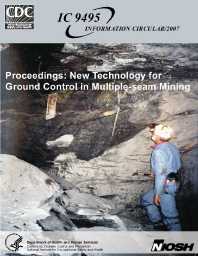Mining Publication: Multiple-Seam Mining in the United States: Background
Original creation date: May 2007
Studies have estimated that 156 billion tons of coal, representing two-thirds of the minable reserves in the United States, are subject to multiple-seam mining. In some U.S. coalfields, particularly in central Appalachia and the West, the majority of today’s mines are operating above and/or beneath previously mined seams. The effects of multiple-seam interactions can include roof falls, rib spalling, and floor heave, which can seriously disrupt mining operations and threaten the safety of miners. In early 2006, a West Virginia coal miner was killed by rib roll that occurred in a high-stress zone beneath a remnant structure in an overlying mine [MSHA 2006]. Fortunately, not every multiple-seam situation results in hazardous conditions. Indeed, the vast majority do not. Accurate prediction of which interactions are likely to be higher-risk allows mine planners to prepare for them or avoid them. Over the years, multiple-seam mining has been the subject of much research, both in the United States and abroad. Much advice on how to mitigate the risk has been presented, but unfortunately it is often contradictory. For example, one group of researchers wrote that "stresses from superincumbent workings are not transferred through shale strata for distances of over 110 ft" [Haycocks et al. 1982], while another group indicated that “a stress transfer distance of 760 ft has been recorded between longwalls” [Haycocks et al. 1992]. For the past several years, the National Institute for Occupational Safety and Health has been conducting research to develop better techniques for predicting the location and severity of multiple-seam interactions. During this investigation, more than 50 mines were visited across the U.S. coalfields. The study also made extensive use of numerical models, particularly the LaModel family of software [Heasley and Agioutantis 2007]. This paper presents the background to that study. The results of the study are discussed by Mark et al. [2007].
Authors: C Mark
Information Circular - May 2007
NIOSHTIC2 Number: 20032063
In: Proceedings: New Technology for Ground Control in Multiple-Seam Mining. Mark C; Tuchman RJ, eds., Pittsburgh, PA: U.S. Department of Health and Human Services, Public Health Service, Centers for Disease Control and Prevention, National Institute for Occupational Safety and Health, DHHS (NIOSH) Publication No. 2007-110, Information Circular 9495, 2007 May; :3-14
See Also
- A Case Study of Multi-Seam Coal Mine Entry Stability Analysis with Strength Reduction Method
- Elastic and Shear Moduli of Coal Measure Rocks Derived from Basic Well Logs Using Fractal Statistics and Radial Basis Functions
- Multiple-Seam Mining in the United States: Design Based on Case Histories
- Pillar Strength and Design Methodology for Stone Mines
- Preventing Equipment Related Injuries in Underground U.S. Coal Mines
- SPONCOM - A Computer Program for the Prediction of the Spontaneous Combustion Potential of an Underground Coal Mine
- Spontaneous Combustion
- Stochastic Modeling of Gob Gas Venthole Production Performances in Active and Completed Longwall Panels of Coal Mines
- Technology News 545 - NIOSH Updates Spontaneous Combustion Assessment Software
- Time-Lapse Tomography of a Longwall Panel: A Comparison of Location Schemes
- Content source: National Institute for Occupational Safety and Health, Mining Program


 ShareCompartir
ShareCompartir
